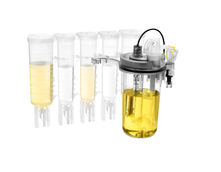Use of low-energy electrons for innovative biotechnology processes
The Fraunhofer Institute for Organic Electronics, Electron Beam and Plasma Technology FEP has been utilizing electron-beam technology for decades in the development of cleaning, sterilization, and surface-modification processes and systems. Fraunhofer researchers from the Medical and Biotechnological Applications division (MBA) now intend to develop a methodology that combines biotechnology processes with low-energy electron-beam technology. Moreover, this hybrid methodology will be combined with existing FEP expertise in the area of sensor technology. The anticipated research program will be presented at the MedtecLIVE trade show in Nuremberg, Hall 10, Booth No. 10.0.513, taking place from March 31 - April 2, 2020.

Fraunhofer researchers from the Medical and Biotechnological Applications division (MBA) now intend to develop a methodology that combines biotechnology processes with low-energy electron-beam technology. Moreover, this hybrid methodology will be combined with existing FEP expertise in the area of sensor technology.
Fraunhofer FEP
The biotechnology sector is a driving force of innovation in the German economy. In particular, the German State of Saxony has developed into one of the most desirable biotech regions and is characterized by a dynamic regional development. Biotechnology is an interdisciplinary field that combines aspects of process engineering with the biological disciplines of genetics, cell biology, and microbiology. Innovative biotechnological processes are making a considerable contribution to the development of alternative, environmentally friendly manufacturing processes.
Bioengineering processes are based on organisms including microorganisms, such as bacteria and yeasts, that are utilized as resource materials for specific industrial processes. The range of biotechnological products is diverse and includes vitamins, pharmaceuticals, cosmetics, detergents, cleaning agents, and fine chemicals.
Low-energy electron treatment is a versatile tool frequently utilized at the Fraunhofer FEP for diverse applications such as sterilizing medical products and dressing seed, to name two. The advantages of using low-energy electron treatment for life-science applications are obvious: the design requirements for shielding are lower, the systems are compact and can therefore be easily integrated into existing production chains, and with this non-thermal process the energy input into the treated product is low.
The visionary goal of the working group for Biotechnology Processes of the MBA division at the Fraunhofer FEP is to combine an existing bioreactor with a low-energy electron source. This hybrid design will facilitate for the first time the direct treatment of liquids using electrons. The hybrid system is superior to individually configured processes in its consumption of both energy and natural resources.
The application fields for the new hybrid technology are diverse and include the pharmaceutical industry and environmental technology. Dr. Simone Schopf, head of the working group for Biotechnological Processes, is convinced that “we can make an important contribution to environmental protection with this novel hybrid technology. For example, we can decompose impurities like drug residues in pharmaceutical wastewater to improve water quality. But the production of biodegradable polymers as an energy-efficient process is also conceivable by using low-energy electron treatment.”
To ensure that the desired biological process in the bioreactor is stable and leads to a high product quality, monitoring and control of process parameters such as temperature and dissolved oxygen level is essential. These factors have a significant influence on the viability and productivity of the organisms, and thus on every step of the process chain. Continuous process analysis is desirable, that is the evaluation of the compliance of optimal growth and product formation conditions in real-time.
Scientists in the Microdisplays and Sensor Technology division at the Fraunhofer FEP faced this challenge through a joint project with the MBA division and combined their expertise in sensor development and biotechnology. Especially for the sensor evaluation in liquids, they established the sensor test bed SensBio by means of a stationary setup, that differs greatly from conventional sensor technology used for gases. At the same time, a novel type of oxygen sensor chip was also developed that has already been successfully tested with a liquid medium in the sensor testbed. Building on this, the scientists want to go a step further and use multi-channel sensors to simultaneously track several parameters on one sensor, thus providing space-saving real-time process monitoring.
Dr. Ulla König, deputy head of the MBA division, is excited: “Scientists of the Fraunhofer FEP are highly motivated to exploit the potential of this novel technology with new and existing partners in manufacturing and R&D across various fields of biotechnology, pharmaceuticals, and medical engineering.”
The SensBio sensor test bed will also be offered as a commercial service to interested external parties for comprehensive sensor validation under standardized environmental conditions.
























































